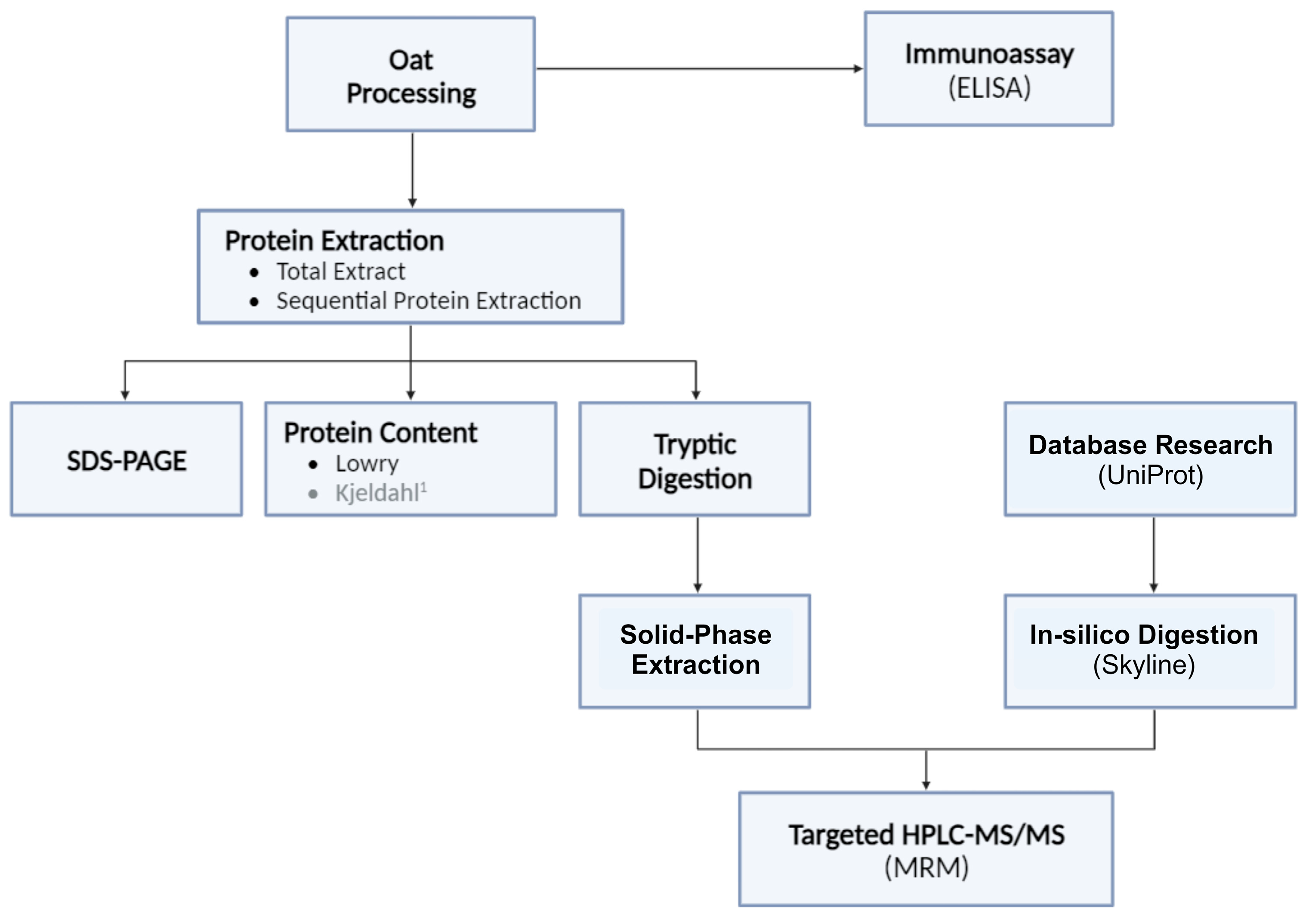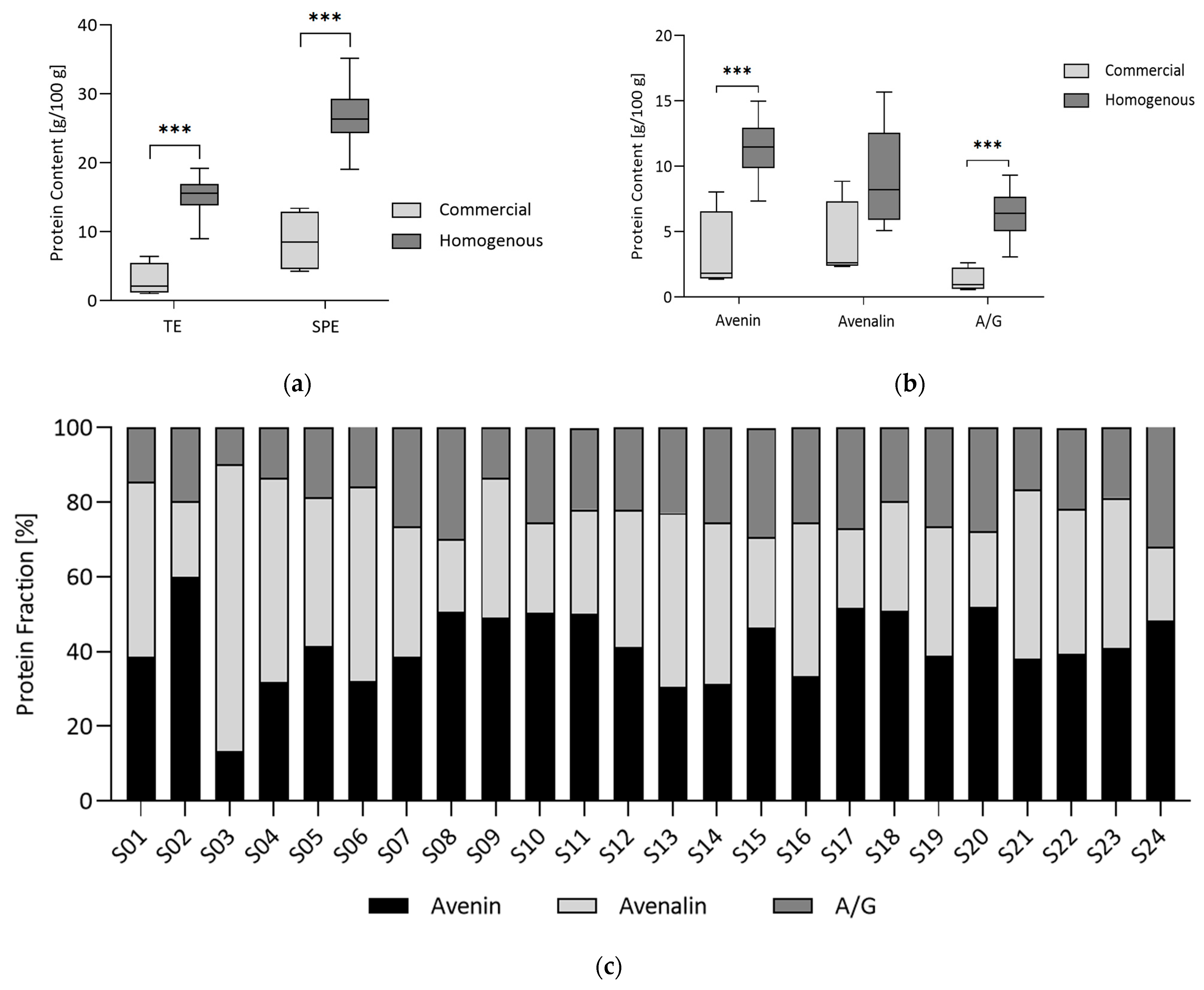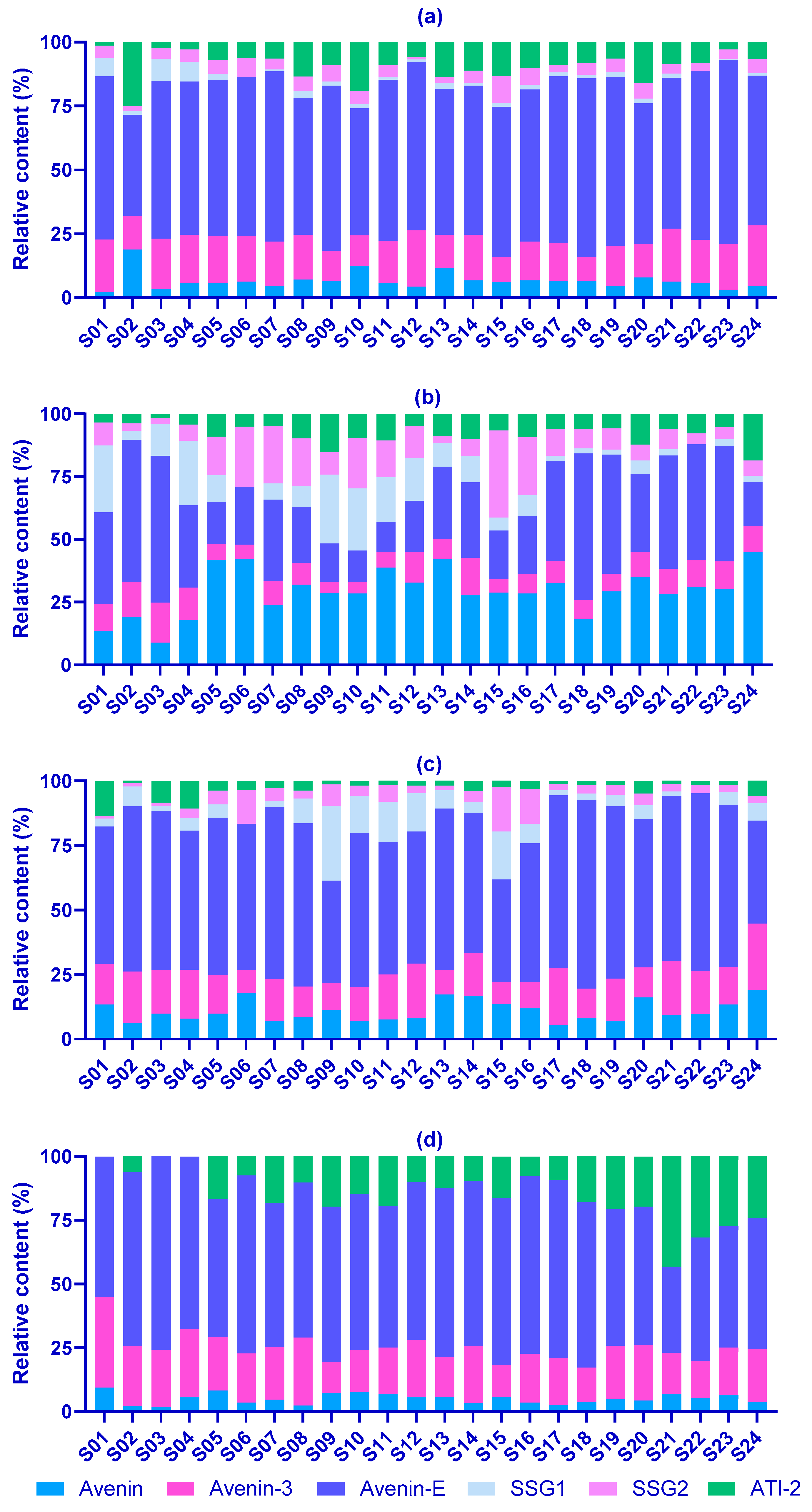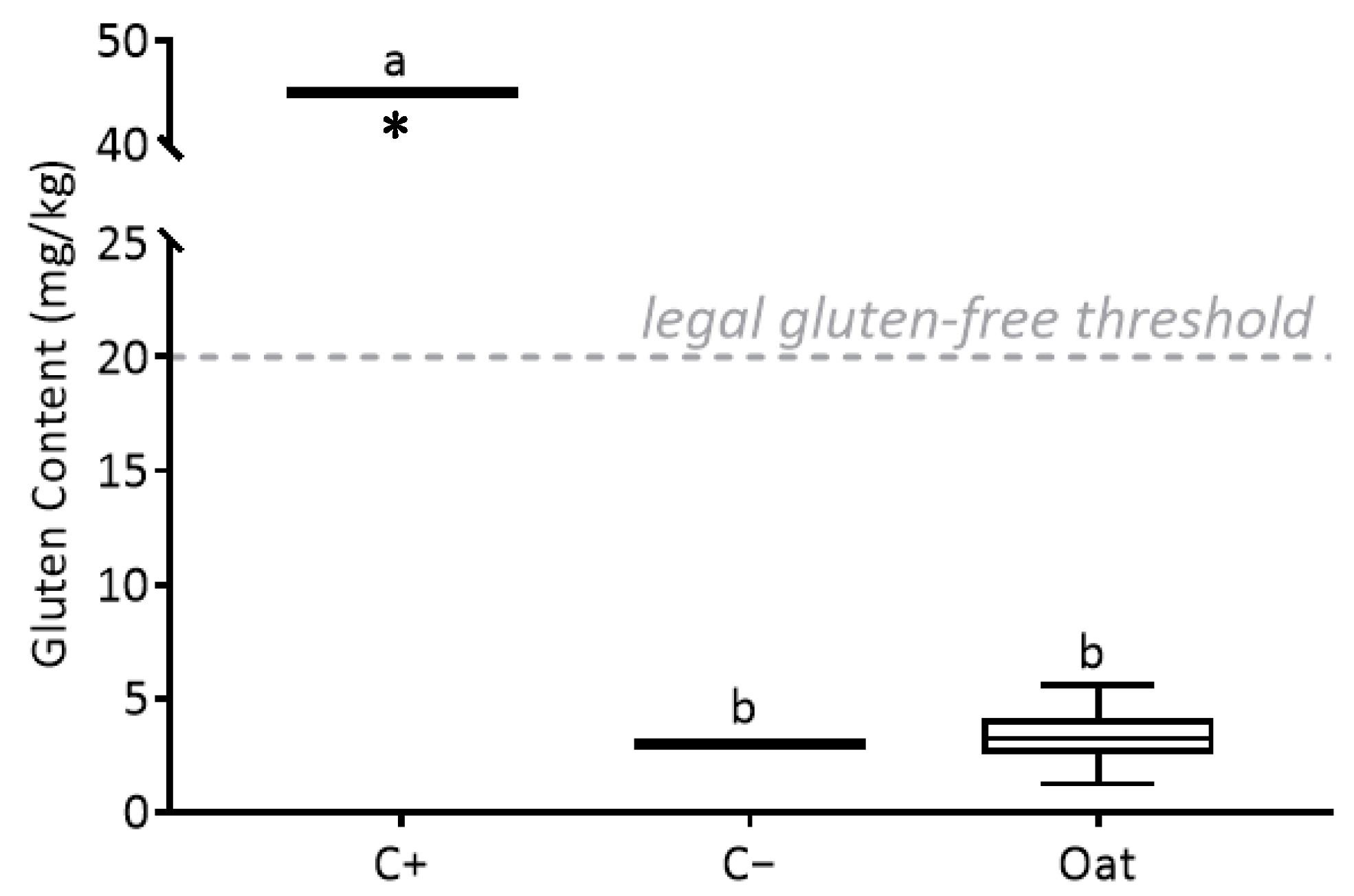The Optimization of the Osborne Extraction Method for the Fractionation and Characterization of Oat Proteins
Abstract
:1. Introduction
2. Materials and Methods
2.1. Materials
2.1.1. Biological Material
2.1.2. Chemicals
2.2. Sample Processing and Protein Extraction
2.2.1. Osborne Extraction
2.2.2. Extraction Optimization
2.2.3. Total Protein Extraction
2.3. Analysis
2.3.1. Nitrogen Content
2.3.2. Protein Concentration
2.3.3. Electrophoresis
2.3.4. Mass Spectrometric Analysis
- Sample preparation
- Method development
2.3.5. Enzyme-Linked Immunosorbent Assay
2.4. Data Processing and Statistical Analysis
3. Results and Discussion
3.1. Optimal Conditions for the Sequential Fractionation
3.2. Relative Content of Avenin, Avenalin, and Albumin/Globumin Fractions in Commercial and Homogenous Samples
3.3. Characterization of the Extracted Proteins
3.4. Gluten Content
4. Conclusions
Supplementary Materials
Author Contributions
Funding
Data Availability Statement
Acknowledgments
Conflicts of Interest
References
- Caio, G.; Volta, U.; Sapone, A.; Leffler, D.A.; De Giorgio, R.; Catassi, C.; Fasano, A. Celiac disease: A comprehensive current review. BMC Med. 2019, 17, 142. [Google Scholar]
- Lebwohl, B.; Rubio-Tapia, A. Epidemiology, presentation, and diagnosis of celiac disease. Gastroenterology 2021, 160, 63–75. [Google Scholar]
- Sagu, S.T.; Zimmermann, L.; Landgraber, E.; Homann, T.; Huschek, G.; Ozpinar, H.; Schweigert, F.J.; Rawel, H.M. Comprehensive characterization and relative quantification of alpha-amylase/trypsin inhibitors from wheat cultivars by targeted hplc-ms/ms. Foods 2020, 9, 1448. [Google Scholar] [PubMed]
- Al-Toma, A.; Volta, U.; Auricchio, R.; Castillejo, G.; Sanders, D.S.; Cellier, C.; Mulder, C.J.; Lundin, K.E.A. European society for the study of coeliac disease (esscd) guideline for coeliac disease and other gluten-related disorders. United Eur. Gastroenterol. J. 2019, 7, 583–613. [Google Scholar]
- Fry, L.; Madden, A.M.; Fallaize, R. An investigation into the nutritional composition and cost of gluten-free versus regular food products in the UK. J. Hum. Nutr. Diet. 2018, 31, 108–120. [Google Scholar] [PubMed]
- El Khoury, D.; Balfour-Ducharme, S.; Joye, I.J. A review on the gluten-free diet: Technological and nutritional challenges. Nutrients 2018, 10, 1410. [Google Scholar] [CrossRef] [PubMed]
- Miranda, J.; Lasa, A.; Bustamante, M.A.; Churruca, I.; Simon, E. Nutritional differences between a gluten-free diet and a diet containing equivalent products with gluten. Plant Foods Hum. Nutr. 2014, 69, 182–187. [Google Scholar]
- Gell, G.; Bugyi, Z.; Florides, C.G.; Birinyi, Z.; Reder, D.; Szego, Z.; Mucsi, E.; Schall, E.; Acs, K.; Lango, B.; et al. Investigation of protein and epitope characteristics of oats and its implications for celiac disease. Front. Nutr. 2021, 8, 702352. [Google Scholar]
- Kumar, L.; Sehrawat, R.; Kong, Y. Oat proteins: A perspective on functional properties. LWT 2021, 152, 112307. [Google Scholar]
- Smulders, M.J.M.; van de Wiel, C.C.M.; van den Broeck, H.C.; van der Meer, I.M.; Israel-Hoevelaken, T.P.M.; Timmer, R.D.; van Dinter, B.J.; Braun, S.; Gilissen, L. Oats in healthy gluten-free and regular diets: A perspective. Food Res. Int. 2018, 110, 3–10. [Google Scholar]
- Kaukovirta-Norja, A.; Lehtinen, P. Traditional and modern oat-based foods. In Technology of Functional Cereal Products; Woodhead Publishing: Cambridge, UK, 2008; pp. 215–232. [Google Scholar]
- Sontag-Strohm, T.; Lehtinen, P.; Kaukovirta-Norja, A. Oat products and their current status in the celiac diet. In Gluten-Free Cereal Products and Beverages; Academic Press: Cambridge, MA, USA, 2008; pp. 191–202. [Google Scholar]
- Spaen, J.; Silva, J.V.C. Oat proteins: Review of extraction methods and techno-functionality for liquid and semi-solid applications. LWT 2021, 147, 111478. [Google Scholar]
- Spector Cohen, I.; Day, A.S.; Shaoul, R. To be oats or not to be? An update on the ongoing debate on oats for patients with celiac disease. Front. Pediatr. 2019, 7, 384. [Google Scholar]
- Comino, I.; Real, A.; de Lorenzo, L.; Cornell, H.; Lopez-Casado, M.A.; Barro, F.; Lorite, P.; Torres, M.I.; Cebolla, A.; Sousa, C. Diversity in oat potential immunogenicity: Basis for the selection of oat varieties with no toxicity in coeliac disease. Gut 2011, 60, 915–922. [Google Scholar]
- Comino, I.; Bernardo, D.; Bancel, E.; de Lourdes Moreno, M.; Sanchez, B.; Barro, F.; Suligoj, T.; Ciclitira, P.J.; Cebolla, A.; Knight, S.C.; et al. Identification and molecular characterization of oat peptides implicated on coeliac immune response. Food Nutr. Res. 2016, 60, 30324. [Google Scholar]
- Osborne, T.B.; Harris, I.F. The chemistry of the protein-bodies of the wheat kernel. Part i.—The protein soluble in alcohol and its glutaminic acid content. Am. J. Physiol.-Leg. Content 1905, 13, 35–44. [Google Scholar]
- Boukid, F. Oat proteins as emerging ingredients for food formulation: Where we stand? Eur. Food Res. Technol. 2021, 247, 535–544. [Google Scholar]
- Shewry, P.R.; Halford, N.G. Cereal seed storage proteins: Structures, properties and role in grain utilization. J. Exp. Bot. 2002, 53, 947–958. [Google Scholar]
- Capouchová, I.; Petr, J.; Tlaskalová-Hogenová, H.; Michalík, I.; Faměra, O.; Urminská, D.; Tučková, L.; Knoblochová, H.; Borovská, D. Protein fractions of oats and possibilities of oat utilisation for patients with coeliac disease. Czech J. Food Sci. 2004, 22, 151–162. [Google Scholar]
- Das, R.S.; Zhu, X.L.; Hannon, S.; Mullins, E.; Alves, S.; Garcia-Vaquero, M.; Tiwari, B.K. Exploring osborne fractionation and laboratory/pilot scale technologies (conventional extraction, ultrasound-assisted extraction, high-pressure processing and hydrodynamic cavitation) for protein extraction from faba bean (Vicia faba L.). Innov. Food Sci. Emerg. Technol. 2023, 89, 103487. [Google Scholar]
- Schmid, M.; Wieser, H.; Koehler, P. Alkylation of free thiol groups during extraction: Effects on the osborne fractions of wheat flour. Cereal Chem. 2017, 94, 546–553. [Google Scholar]
- DuPont, F.M.; Chan, R.; Lopez, R.; Vensel, W.H. Sequential extraction and quantitative recovery of gliadins, glutenins, and other proteins from small samples of wheat flour. J. Agric. Food Chem. 2005, 53, 1575–1584. [Google Scholar] [PubMed]
- Sagu, S.T.; Nso, E.J.; Karmakar, S.; De, S. Optimisation of low temperature extraction of banana juice using commercial pectinase. Food Chem. 2014, 151, 182–190. [Google Scholar]
- Tchewonpi Sagu, S.; Huschek, G.; Bonick, J.; Homann, T.; Rawel, H.M. A new approach of extraction of alpha-amylase/trypsin inhibitors from wheat (Triticum aestivum L.), based on optimization using plackett-burman and box-behnken designs. Molecules 2019, 24, 3589. [Google Scholar] [PubMed]
- Kjeldahl, J. Neue methode zur bestimmung des stickstoffs in organischen körpern. Fresenius‘ Z. Für Anal. Chem. 1883, 22, 366–382. [Google Scholar]
- Lowry, O.; Rosebrough, N.; Farr, A.L.; Randall, R. Protein measurement with the folin phenol reagent. J. Biol. Chem. 1951, 193, 265–275. [Google Scholar] [PubMed]
- Sagu, S.T.; Rawel, H.M.; Rohn, S. Targeted bottom-up mass spectrometry approach for the relative quantification of post-translational modification of bovine kappa-casein during milk fermentation. Molecules 2022, 27, 5834. [Google Scholar]
- Sagu, S.T.; Huschek, G.; Homann, T.; Rawel, H.M. Effect of sample preparation on the detection and quantification of selected nuts allergenic proteins by lc-ms/ms. Molecules 2021, 26, 4698. [Google Scholar] [CrossRef]
- Sagu, S.T.; Landgraber, E.; Rackiewicz, M.; Huschek, G.; Rawel, H. Relative abundance of alpha-amylase/trypsin inhibitors in selected sorghum cultivars. Molecules 2020, 25, 5982. [Google Scholar] [CrossRef]
- Sunilkumar, B.A.; Leonova, S.; Öste, R.; Olsson, O. Identification and characterization of high protein oat lines from a mutagenized oat population. J. Cereal Sci. 2017, 75, 100–107. [Google Scholar]
- Guan, X.; Yao, H. Optimization of viscozyme l-assisted extraction of oat bran protein using response surface methodology. Food Chem. 2008, 106, 345–351. [Google Scholar]
- Senarathna, S.; Mel, R.; Malalgoda, M. Utilization of cereal-based protein ingredients in food applications. J. Cereal Sci. 2024, 116, 103867. [Google Scholar]
- Goncharov, A.A.; Safonov, T.A.; Malko, A.M.; Bocharov, G.A.; Goncharov, S.V. Climate change expected to increase yield of spring cereals and reduce yield of winter cereals in the western siberian grain belt. Field Crop. Res. 2023, 302, 109038. [Google Scholar]
- Xiang, X.; Solaymani, S. Change in cereal production caused by climate change in malaysia. Ecol. Inform. 2022, 70, 101741. [Google Scholar]
- Sagu, S.T.; Ulbrich, N.; Morche, J.R.; Nichani, K.; Ozpinar, H.; Schwarz, S.; Henze, A.; Rohn, S.; Rawel, H.M. Formation of cysteine adducts with chlorogenic acid in coffee beans. Foods 2024, 13, 1660. [Google Scholar] [CrossRef]
- Li, R.; Xiong, Y.L. Ultrasound-induced structural modification and thermal properties of oat protein. LWT 2021, 149, 111861. [Google Scholar]
- Geisslitz, S.; Islam, S.; Buck, L.; Grunwald-Gruber, C.; Sestili, F.; Camerlengo, F.; Masci, S.; D’Amico, S. Absolute and relative quantitation of amylase/trypsin-inhibitors by lc-ms/ms from wheat lines obtained by crispr-cas9 and rnai. Front. Plant Sci. 2022, 13, 974881. [Google Scholar]
- Klose, C.; Arendt, E.K. Proteins in oats; their synthesis and changes during germination: A review. Crit. Rev. Food Sci. Nutr. 2012, 52, 629–639. [Google Scholar]





| Exp. No. | Coded Values | Real Values | Protein Concentration (mg/mL) | Extraction Yield (%) | ||||||||
|---|---|---|---|---|---|---|---|---|---|---|---|---|
| x1 | x2 | x3 | X1 | X2 | X3 | Avenin Fraction | Avenalin Fraction | Albumin/ Globulin Fraction | Avenin Fraction | Avenalin Fraction | Albumin/ Globulin Fraction | |
| 1 | −1 | −1 | 0 | 1 | 0.8 | 27.5 | 0.596 | 1.496 | 0.382 | 2.0 | 2.2 | 1.3 |
| 2 | 1 | −1 | 0 | 10 | 0.8 | 27.5 | 1.060 | 1.683 | 0.304 | 3.4 | 2.4 | 1.0 |
| 3 | −1 | 1 | 0 | 1 | 6 | 27.5 | 0.913 | 2.031 | 0.139 | 2.9 | 2.9 | 0.5 |
| 4 | 1 | 1 | 0 | 10 | 6 | 27.5 | 0.742 | 2.187 | 0.024 | 2.4 | 3.2 | 0.1 |
| 5 | −1 | 0 | −1 | 1 | 3.4 | 5 | 0.514 | 0.407 | 0.084 | 9.7 | 3.2 | 1.6 |
| 6 | 1 | 0 | −1 | 10 | 3.4 | 5 | 0.417 | 0.620 | 0.211 | 7.4 | 4.9 | 3.7 |
| 7 | −1 | 0 | 1 | 1 | 3.4 | 50 | 0.967 | 2.349 | 1.064 | 1.5 | 1.8 | 1.6 |
| 8 | 1 | 0 | 1 | 10 | 3.4 | 50 | 0.839 | 2.789 | 1.195 | 1.3 | 2.2 | 1.8 |
| 9 | 0 | −1 | −1 | 5.5 | 0.8 | 5 | 0.308 | 0.557 | 0.226 | 5.6 | 4.3 | 4.1 |
| 10 | 0 | 1 | −1 | 5.5 | 6 | 5 | 0.488 | 0.510 | 0.325 | 8.7 | 3.8 | 5.8 |
| 11 | 0 | −1 | 1 | 5.5 | 0.8 | 50 | 0.599 | 2.725 | 1.076 | 0.9 | 2.2 | 1.7 |
| 12 | 0 | 1 | 1 | 5.5 | 6 | 50 | 0.911 | 2.600 | 1.195 | 1.4 | 2.1 | 1.9 |
| 13 | 0 | 0 | 0 | 5.5 | 3.4 | 27.5 | 1.209 | 1.006 | 0.507 | 3.9 | 1.4 | 1.6 |
| 14 | 0 | 0 | 0 | 5.5 | 3.4 | 27.5 | 1.237 | 1.145 | 0.493 | 4.0 | 1.6 | 1.6 |
| 15 | 0 | 0 | 0 | 5.5 | 3.4 | 27.5 | 1.265 | 1.285 | 0.479 | 4.2 | 1.9 | 1.6 |
| Sample Nr. | Protein Content [g/100 g] | |||
|---|---|---|---|---|
| Sequential Protein Extraction | Total Extraction (Ambi/Urea Method) | |||
| Avenin | Avenalin | A/G | ||
| S01 | 2.11 ± 0.28 a | 2.55 ± 0.12 a | 0.79 ± 0.13 a | 2.70 ± 0.16 a |
| S02 | 8.05 ± 0.03 b | 2.71 ± 0.18 a | 2.63 ± 0.07 b | 6.42 ± 0.48 b |
| S03 | 1.54 ± 0.35 a | 8.83 ± 0.00 b | 1.12 ± 0.03 a,b | 1.03 ± 0.73 a |
| S04 | 1.36 ± 0.17 a | 2.33 ± 0.09 a | 0.57 ± 0.01 a | 1.55 ± 0.07 a |
| S05 | 8.17 ± 0.17 b | 7.84 ± 0.21 b,c | 3.66 ± 0.00 b,c | 14.99 ± 0.39 c |
| S06 | 9.70 ± 0.25 b | 15.68 ± 0.69 d | 4.76 ± 0.06 c,d | 16.94 ± 0.39 d |
| S07 | 7.33 ± 0.62 b | 6.64 ± 0.28 c,d | 5.0 ± 0.136 c,e | 8.97 ± 0.43 e |
| S08 | 13.09 ± 0.51 c | 5.10 ± 0.11 d,e | 7.73 ± 0.37 f | 13.12 ± 0.42 f |
| S09 | 11.16 ± 1.23 d | 8.54 ± 0.25 b | 3.06 ± 0.13 b,c | 15.81 ± 1.61 c,d |
| S10 | 12.37 ± 0.76 c,d | 5.89 ± 0.70 e,f | 6.28 ± 0.13 d,e,f,g | 15.23 ± 0.55 c,d |
| S11 | 12.99 ± 1.27 c | 7.19 ± 0.00 b,d,f | 5.68 ± 0.24 d,e | 18.12 ± 1.12 d,g |
| S12 | 10.97 ± 0.68 d | 9.81 ± 0.33 b,d,g | 5.91 ± 0.01 d,e | 17.29 ± 0.19 d |
| S13 | 8.97 ± 0.51 b,e | 13.67 ± 0.65 h,j | 6.75 ± 0.17 e,f | 15.81 ± 0.16 c,d |
| S14 | 8.59 ± 0.09 b,e | 11.90 ± 0.42 h,i | 6.96 ± 0.16 f | 18.28 ± 1.01 d,g |
| S15 | 11.09 ± 0.36 d | 5.84 ± 1.03 d,e | 7.00 ± 0.08 f | 12.29 ± 0.23 f |
| S16 | 10.34 ± 0.36 d,e | 12.70 ± 1.22 h,j | 7.83 ± 0.03 f | 15.31 ± 1.61 c,d |
| S17 | 12.48 ± 0.29 c,d | 5.21 ± 0.42 d,e | 6.53 ± 0.16 d,f | 14.29 ±0.00 c,f |
| S18 | 12.82 ± 0.64 c,d | 7.43 ± 0.06 b,d,f | 5.00 ± 0.15 c,d,g | 13.65 ± 0.24 c,f |
| S19 | 13.70 ± 0.18 c | 12.16 ± 1.36 h,j | 9.30 ± 0.06 f | 19.16 ±0.60 g |
| S20 | 14.96 ± 0.92 | 5.90 ± 0.10 d,e | 7.98 ± 0.12 f | 16.23 ± 1.30 c,d |
| S21 | 10.98 ± 0.59 d | 13.12 ± 0.19 h,j | 4.79 ± 0.37 c,g | 16.89 ± 2.38 d |
| S22 | 13.56 ± 0.06 c | 13.29 ± 0.30 h,j | 7.49 ± 0.35 f | 16.80 ± 0.04 d |
| S23 | 11.79 ± 0.65 c,d | 11.55 ± 0.92 g,i,j, | 5.42 ± 0.04 c,g | 14.76 ± 0.44 c,f |
| S24 | 12.40 ± 0.51 c,d | 5.08 ± 0.11 d,e | 8.24 ± 0.15 f | 11.99 ± 1.03 f |
Disclaimer/Publisher’s Note: The statements, opinions and data contained in all publications are solely those of the individual author(s) and contributor(s) and not of MDPI and/or the editor(s). MDPI and/or the editor(s) disclaim responsibility for any injury to people or property resulting from any ideas, methods, instructions or products referred to in the content. |
© 2024 by the authors. Licensee MDPI, Basel, Switzerland. This article is an open access article distributed under the terms and conditions of the Creative Commons Attribution (CC BY) license (https://creativecommons.org/licenses/by/4.0/).
Share and Cite
Sagu, S.T.; Wiedemann, L.T.; Nichani, K.; Henze, A.; Rawel, H.M. The Optimization of the Osborne Extraction Method for the Fractionation and Characterization of Oat Proteins. Separations 2024, 11, 271. https://doi.org/10.3390/separations11090271
Sagu ST, Wiedemann LT, Nichani K, Henze A, Rawel HM. The Optimization of the Osborne Extraction Method for the Fractionation and Characterization of Oat Proteins. Separations. 2024; 11(9):271. https://doi.org/10.3390/separations11090271
Chicago/Turabian StyleSagu, Sorel Tchewonpi, Lara Talea Wiedemann, Kapil Nichani, Andrea Henze, and Harshadrai M. Rawel. 2024. "The Optimization of the Osborne Extraction Method for the Fractionation and Characterization of Oat Proteins" Separations 11, no. 9: 271. https://doi.org/10.3390/separations11090271








